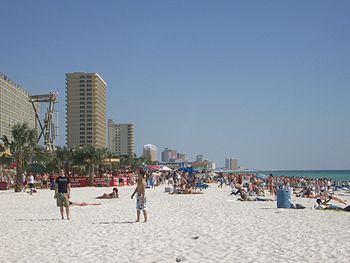- Spring break
-
For other uses, see Spring break (disambiguation).
Spring break – also known as March break, Study week or Reading week in the United Kingdom and some parts of Canada – is a recess in early spring at universities and schools in the United States, Canada, mainland China, Korea, Japan, Taiwan, Mexico, the Dominican Republic, the United Kingdom, and other countries.
Contents
Timing
In the United States, spring break at the college and university level can occur from February to April, depending on term dates and certain holidays. Many K–12 institutions in the United States schedule their spring breaks around Easter and Passover.
Canada gives a week-long break to its elementary school and secondary school students in the month of March, with the time varying from province to province; New Brunswick and Quebec, for example, place their March breaks during the first week of March; Ontario, Nova Scotia and British Columbia schedule theirs during the second or third week; and the break in Alberta usually occurs in the last week of March. United Kingdom schools schedule two-week holidays known as the "Easter break" or "Easter holidays", as they occur in the weeks following and preceding Easter.
In Japan, the spring break starts with the end of the academic year in March and ends on April 1 with the beginning of a new academic year, while in Guatemala it takes place during Easter, schools give students a whole week to rest while the workforce just rest around 3 days. In Mexico it takes place at the last 2 weeks of March, usually during the Easter week, and the one before it, and in Brazil, it is commonly known as the "boredom week" and grew around two public holidays, October 12—the feast of Our Lady of Aparecida, patron saint of the country—and October 15, Teacher's Day.
History
From the end of World War II until the 1980s, Fort Lauderdale, Florida, was a notorious spring break destination in the United States for college students. It was largely made so by the efforts of one man, George Warren "Bob" Gill Jr., who was called "the Father of Fort Lauderdale spring break".[1] Prior to that, a few were coming to the area for a break from winter cold. Fort Lauderdale's reputation as a spring break destination for college students started when the Colgate University men's swimming team went to practice there over break in 1935.[2] Fort Lauderdale became even more popular due to the 1960 film Where the Boys Are, in which college girls met boys while on spring break there. Residents of the Fort Lauderdale area became so upset at the damage done by vacationers that the local government passed laws restricting parties in 1985. At the same time, the National Minimum Drinking Age Act was enacted in the United States, requiring that Florida raise the minimum drinking age to 21 and inspiring many underage college vacationers to travel outside the United States for spring break. By 1989, the number of college vacationers traveling to Fort Lauderdale fell to 20,000, a far cry from the 350,000 who went four years prior.[3]
Spring break party goers responded by moving to the more permissive community of Daytona Beach area (over 200,000 students traveled there each spring at its peak), but after Daytona's local government undertook similar measures, the crowds of the mid-1990s and early 2000s had fallen to a point where "a few students still come, but officials don't even estimate their numbers". Panama City Beach, Florida remains a popular spring break destination due to its relative proximity to many Southern colleges and driving distances. The locals in Panama City Beach welcome Spring Breakers every year, and Spring Break is a major factor in the city's economy. South Padre Island, Texas, and Fort Myers Beach, Florida, are also popular Spring Break destinations among students from colleges in the south-central and midwestern parts of the country. One of the biggest in the Southwest, popularized by MTV, is Lake Havasu City, Arizona. One of the new up and coming destinations for Spring Break is Las Vegas, Nevada. In March 2011, MTV hosted its annual Spring Break at the Palms Hotel and Casino. Las Vegas is one of the top domestic Spring Break destinations.
Popular destinations outside the United States include Cancún, Cabo San Lucas, Acapulco, Barbados, Mazatlán, Puerto Vallarta, Dominican Republic, Jamaica, the Bahamas, the Turks and Caicos Islands and Varadero, Cuba, for non-US citizens. Tour agencies have not only cited the lower drinking ages in these places, but also the fact that the drinking ages are poorly enforced. Some tour companies put on special chartered flights for Spring Break at discounted rates.
It is common for major brands that cater to the youth market, e.g., Coca-Cola, Gillette, MTV, and branches of the United States armed forces, to market heavily at spring break destinations.
Some colleges offer "alternate spring breaks" in which students volunteer community service and charity work during spring break.
See also
References
- Notes
- ^ "Obituary: George Warren 'Bob' Gill Jr." Miami Herald
- ^ Marsh, Bill. "The Innocent Birth of the Spring Bacchanal". The New York Times, March 19, 2006.
- ^ Fort Lauderdale Travel Guide | Fodor's Online
External links
 Media related to Spring break at Wikimedia Commons
Media related to Spring break at Wikimedia Commons
Categories:- Secular holidays
- Spring
- Student culture
- Types of tourism
Wikimedia Foundation. 2010.

